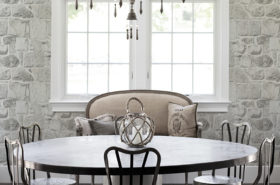When it comes to adding show-stopping style to your home, wallpaper is a major game-changer. And with endless options to choose from, there’s a wallpaper for every interior design style. However, people often hesitate to embrace wallpaper because of its outdated reputation of being difficult to work with and harder still to remove.
The reality is that wallpaper has never been easier to work with than now! Advancements in materials used and types of wallpaper created have made installation and removal a dream. To determine which type of wallpaper is best for you, consider these key factors in addition to its design:
Types of Wallpaper Substrates
Style that works for your lifestyle is key to picking a wallpaper you’ll love for years to come. There are many types of wallpaper materials, each with varying levels of durability and delicacy in maintenance required. Here’s a basic rundown on the types of wallpaper substrates and the upkeep required:

Non-Woven Wallpaper: The modern standard for high performance wallpaper, non-woven wallpapers are easier to install and remove than traditional materials. In fact, non-woven wallpapers have become the most popular wallpaper option since first introduced at the turn of the century!
Made of fibrous materials and free of vinyl, non-woven designs are also an environmentally friendly choice. Overall, they’re one of the best opinions on the market and great for people who change up their style often.
Vinyl Wallpapers: The historical material choice for wallpaper, vinyl is incredibly durable and easy to maintain. Vinyl wallpapers stand up well against long-term exposure to humidity, which makes them perfect for kitchens and bathrooms. Plus, the thick material allows for luxurious finishes, like embossing and expanded inks, that create spectacular textures.


Paper Wallpapers: Once very common, paper wallpapers are now much less common. Environmentally friendly and great for colorful and complex designs, they’re also very delicate, easy to damage, and more difficult to remove.
Grasscloth Wallpaper: Woven from natural fibers, grasscloth wallpapers are unique, hand-crafted items. These environmentally friendly designs are highly textured for a timeless and elegant look.
However, we wouldn’t recommend this type of wallpaper for kitchens or bathrooms. Grasscloths also require slightly more upkeep and potentially professional cleaning; luckily, faux grasscloth wallpapers provide a low-maintenance alternative.

Speaking of upkeep, ease of maintenance is broken down into three categories:
- Wipe with a Damp Cloth: The most delicate of wallpapers must be carefully spot-cleaned.
- Washable: These wallpapers can be lightly cleaned with a sponge or damp cloth, though a gentle hand is still needed.
- Scrubbable: The easiest to clean, these wallpapers can be treated with a sponge and mild soap or detergent.
Ease of Installation & Removal
Now that we’ve gone over the different types of wallpaper and how to care for them, let’s talk installation. While improvements in the substrates has made wallpaper all-around easier to install, you may prefer one method over another. Here’s a quick run-down:
By far the easiest to install – and remove! – is peel and stick wallpaper. This vinyl-based substrate is treated with a self-adhesive and requires no additional preparations. Just peel off the backing and smooth into onto your wall – though if your wall is textured, this wallpaper will not hold.
Traditional wallpaper, on the other hand, can be installed several ways. Unpasted wallpapers can be installed either by Pasting the Wall or Pasting the Paper. We recommend the Paste the Wall method unless your chosen wallpaper specifies otherwise, as it’s the cleanest application method.
Pre-Pasted wallpaper is the most labor-intensive. Each strip needs to be briefly soaked in water and allowed to cure before hanging on the wall. This can be time-consuming, and the wet wallpaper tends to be heavier and more difficult to work with than with the Paste the Wall or Paste the Paper methods.

If you’re looking at traditional wallpaper, and if you can see yourself redesigning the area you’re wallpapering in a few years’ time, then you should know how easy your wallpaper will be to remove:
Strippable wallpaper is by far the easiest to remove and can be taken down without leaving any backing behind. Non-woven wallpapers are typically strippable.
Wet strippable wallpaper – as the name implies – can be removed in large swathes without leaving backing behind, but only after being thoroughly soaked with water.
Peelable wallpaper comes off the wall, but some backing may be left behind. The backing can be removed, typically with just a little soap and water, but it occasionally may require wallpaper removal solution. Paper-baked and vinyl wallpapers are typically peelable.
Wallpaper brings character and dimension to your space that’s difficult to achieve with paint alone. Don’t let outdated assumptions about wallpaper scare you away from using it; be empowered and learn which types of wallpaper will complete your vision, both aesthetically and functionally.

A design enthusiast thrilled to be decorating her first & forever home, Jen covers all things interiors with a special emphasis on strategies for developing beautifully simple and simply beautiful style. When not mentally curating her dream home, she can be found honing her submissions skills in Brazilian Jiu-Jitsu and Krav Maga.


